Related Research Articles

Banksia subg. Isostylis is a subgenus of Banksia. It contains three closely related species, all of which occur only in Southwest Western Australia. Members of subgenus Isostylis have dome-shaped flower heads that are superficially similar to those of B. ser. Dryandra, but structurally more like reduced versions of the "flower spikes" characteristic of most other Banksia taxa.

Banksia subg. Banksia is a valid botanic name for a subgenus of Banksia. As an autonym, it necessarily contains the type species of Banksia, B. serrata. Within this constraint, however, there have been various circumscriptions.

Banksia spinulosa, the hairpin banksia, is a species of woody shrub, of the genus Banksia in the family Proteaceae, native to eastern Australia. Widely distributed, it is found as an understorey plant in open dry forest or heathland from Victoria to northern Queensland, generally on sandstone though sometimes also clay soils. It generally grows as a small shrub to 2 metres (7 ft) in height, though can be a straggly tree to 6 metres (20 ft). It has long narrow leaves with inflorescences which can vary considerably in coloration; while the spikes are gold or less commonly yellowish, the emergent styles may be a wide range of colours – from black, purple, red, orange or yellow.
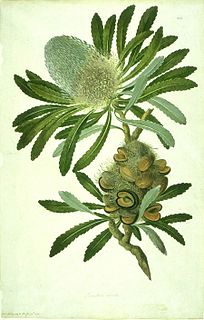
As with other flowering plants, the taxonomy of Banksia has traditionally been based on anatomical and morphological properties of the Banksia flower, fruiting structure and seed, along with secondary characteristics such as leaf structure and growth habit. Increasingly, molecular evidence from DNA is providing important new insights into relationships within the genus and between this and other genera in the Proteaceae.
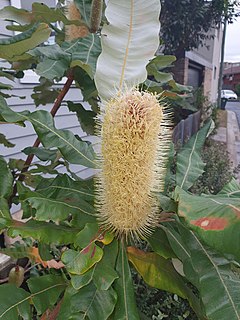
Banksia dentata, commonly known as the tropical banksia, is a species of tree in the genus Banksia. It occurs across northern Australia, southern New Guinea and the Aru Islands. Growing as a gnarled tree to 7 m (23 ft) high, it has large green leaves up to 22 cm (8.7 in) long with dentate (toothed) margins. The cylindrical yellow inflorescences, up to 13 cm (5.1 in) high, appear over the cooler months, attracting various species of honeyeaters, sunbirds, the sugar glider and a variety of insects. Flowers fall off the ageing spikes, which swell and develop follicles containing up to two viable seeds each.
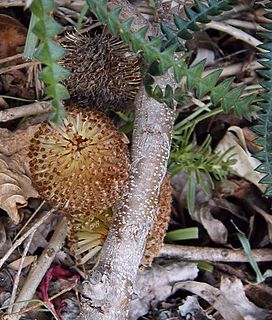
Banksia dryandroides, the dryandra-leaved banksia, is a species of small shrub in the plant genus Banksia. The Noongar peoples know the tree as manyat. It occurs in shrubland, woodland and kwongan on the south coast of Western Australia between Narrikup and Beaufort Inlet. The species is placed alone in series B. ser. Dryandroideae.
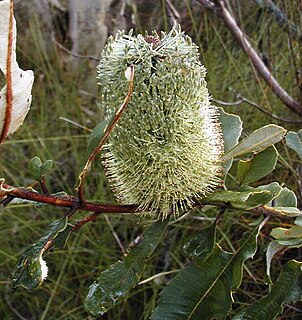
Banksia oblongifolia, commonly known as the fern-leaved, dwarf or rusty banksia, is a species in the plant genus Banksia. Found along the eastern coast of Australia from Wollongong, New South Wales in the south to Rockhampton, Queensland in the north, it generally grows in sandy soils in heath, open forest or swamp margins and wet areas. A many-stemmed shrub up to 3 m (9.8 ft) high, it has leathery serrated leaves and rusty-coloured new growth. The yellow flower spikes, known as inflorescences, most commonly appear in autumn and early winter. Up to 80 follicles, or seed pods, develop on the spikes after flowering. Banksia oblongifolia resprouts from its woody lignotuber after bushfires, and the seed pods open and release seed when burnt, the seed germinating and growing on burnt ground. Some plants grow between fires from seed shed spontaneously.
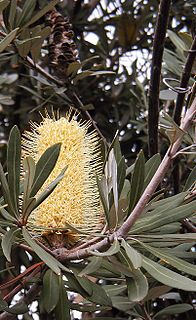
Banksia ser. Salicinae is a valid botanic name for a series of Banksia. First published by Carl Meissner in 1856, the name has had three circumscriptions.

The taxonomy of Banksia integrifolia has a long and complex history, the result of confusion caused by the species' great variability, and similarities with some closely related species. The existence of hybrids between B. integrifolia and related species as well as early attempts to classify the species based on dried specimen material have also contributed to the confusion.
This is a timeline of developments in knowledge and understanding of the Australian plant genus Banksia:
Dryandra subg. Diplophragma is an obsolete subgenus within the former genus Dryandra. It was first published by Robert Brown in 1830, but was discarded by George Bentham in 1870. It was reinstated with a new circumscription by Alex George in 1996, but was ultimately discarded again in 2007 when Austin Mast and Kevin Thiele sunk Dryandra into Banksia.

George Bentham's taxonomic arrangement of Banksia was published in 1870, in Volume 5 of Bentham's Flora Australiensis. A substantial improvement on the previous arrangement, it would stand for over a century. It was eventually replaced by Alex George's 1981 arrangement, published in his classic monograph The genus Banksia L.f. (Proteaceae).
Kevin Thiele and Pauline Ladiges taxonomic arrangement of Banksia, published in 1996, was a novel taxonomic arrangement that was intended to align the taxonomy of Banksia more closely with the phylogeny that they had inferred from their cladistic analysis of the genus. It replaced Alex George's 1981 arrangement, but most aspects were not accepted by George, and it was soon replaced by a 1999 revision of George's arrangement. However some herbaria have continued to follow Thiele and Ladiges on some points.
Carl Meissner's taxonomic arrangement of Banksia was published in 1856, as part of his chapter on the Proteaceae in A. P. de Candolle's Prodromus systematis naturalis regni vegetabilis. It was the first attempt to provide an infrageneric classification for the genus, aside from Robert Brown's publication of two subgenera in 1810. Meissner's arrangement stood until 1870, when it was superseded by the arrangement of George Bentham. Meissner's arrangement was an excellent survey of the known species at that time, but his infrageneric taxa were all highly heterogeneous.

Alex George's taxonomic arrangement of Banksia was the first modern-day arrangement for that genus. First published in 1981 in the classic monograph The genus Banksia L.f. (Proteaceae), it superseded the arrangement of George Bentham, which had stood for over a hundred years. It was overturned in 1996 by Kevin Thiele and Pauline Ladiges, but restored by George in 1999. A recent publication by Austin Mast and Kevin Thiele suggests that it will soon be overturned again.

Banksia sect. Eubanksia is an obsolete section of Banksia. There have been two circumscriptions, one of which is synonymous with the recently abandoned B. subg. Banksiasensu Alex George, the other having no modern equivalent.
Robert Brown's taxonomic arrangement of Dryandra was the first arrangement of what is now Banksia ser. Dryandra. His initial arrangement was published in 1810, and a further arrangement, including an infrageneric classification, followed in 1830. Aspects of Brown's arrangements can be recognised in the later arrangements of George Bentham and Alex George.

Banksia spinulosa var. collina is a shrub that grows along the east coast of Australia, in Queensland and New South Wales. Commonly known as Hill Banksia or Golden Candlesticks, it is a taxonomic variety of B. spinulosa. It is a popular garden plant widely sold in nurseries.

Banksia spinulosa var. spinulosa is a shrub that grows along the east coast of Australia, in Queensland and New South Wales.
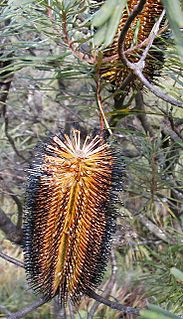
Banksia spinulosa var. cunninghamii, sometimes given species rank as Banksia cunninghamii, is a shrub that grows along the east coast of Australia, in Victoria and New South Wales. It is a fast-growing non-lignotuberous shrub or small tree infrequently cultivated.
References
- 1 2 Brown, Robert (1810). Prodromus Florae Novae Hollandiae et Insulae Van Diemen. London: Taylor.
- 1 2 Brown, Robert (1830). Supplementum Primum Prodromi Florae Novae Hollandiae. London: Taylor.
- ↑ George, Alex S. (1981). "The Genus Banksia L.f. (Proteaceae)". Nuytsia . 3 (3): 239–473.
- ↑ George, Alex S. (1999). "Banksia". In Wilson, Annette (ed.). Flora of Australia . Vol. 17B: Proteaceae 3: Hakea to Dryandra. CSIRO Publishing / Australian Biological Resources Study. pp. 175–251. ISBN 0-643-06454-0.
- ↑ Mast, Austin R. (1998). "Molecular systematics of subtribe Banksiinae (Banksia and Dryandra; Proteaceae) based on cpDNA and nrDNA sequence data: implications for taxonomy and biogeography". Australian Systematic Botany. 11 (4): 321–342. doi:10.1071/SB97026.
- ↑ Mast, Austin R.; Givnish, Thomas J. (2002). "Historical biogeography and the origin of stomatal distributions in Banksia and Dryandra (Proteaceae) based on Their cpDNA phylogeny". American Journal of Botany . 89 (8): 1311–1323. doi: 10.3732/ajb.89.8.1311 . ISSN 0002-9122. PMID 21665734 . Retrieved 2006-07-02.
- ↑ Mast, Austin R.; Eric H. Jones & Shawn P. Havery (2005). "An assessment of old and new DNA sequence evidence for the paraphyly of Banksia with respect to Dryandra (Proteaceae)". Australian Systematic Botany. CSIRO Publishing / Australian Systematic Botany Society. 18 (1): 75–88. doi:10.1071/SB04015.
- ↑ Mast, Austin R.; Thiele, Kevin (2007). "The transfer of Dryandra R.Br. to Banksia L.f. (Proteaceae)". Australian Systematic Botany . 20: 63–71. doi:10.1071/SB06016.